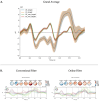Artifact filtering application to increase online parity in a communication BCI: progress toward use in daily-life
- PMID: 40104767
- PMCID: PMC11914135
- DOI: 10.3389/fnhum.2025.1551214
Artifact filtering application to increase online parity in a communication BCI: progress toward use in daily-life
Abstract
A significant challenge in developing reliable Brain-Computer Interfaces (BCIs) is the presence of artifacts in the acquired brain signals. These artifacts may lead to erroneous interpretations, poor fitting of models, and subsequent reduced online performance. Furthermore, BCIs in a home or hospital setting are more susceptible to environmental noise. Artifact handling procedures aim to reduce signal interference by filtering, reconstructing, and/or eliminating unwanted signal contaminants. While straightforward conceptually and largely undisputed as essential, suitable artifact handling application in BCI systems remains unsettled and may reduce performance in some cases. A potential confound that remains unexplored in the majority of BCI studies using these procedures is the lack of parity with online usage (e.g., online parity). This manuscript compares classification performance between frequently used offline digital filtering, using the whole dataset, and an online digital filtering approach where the segmented data epochs that would be used during closed-loop control are filtered instead. In a sample of healthy adults (n = 30) enrolled in a BCI pilot study to integrate new communication interfaces, there were significant benefits to model performance when filtering with online parity. While online simulations indicated similar performance across conditions in this study, there appears to be no drawback to the approach with greater online parity.
Keywords: EEG; N200 and P300 potentials; artifact handling; brain computer interface; cBCI; online parity; signal filtering; signal processing.
Copyright © 2025 Memmott, Klee, Smedemark-Margulies and Oken.
Conflict of interest statement
The authors declare that the research was conducted in the absence of any commercial or financial relationships that could be construed as a potential conflict of interest. The author(s) declared that they were an editorial board member of Frontiers, at the time of submission. This had no impact on the peer review process and the final decision.
Figures






Similar articles
-
Methods for motion artifact reduction in online brain-computer interface experiments: a systematic review.Front Hum Neurosci. 2023 Oct 18;17:1251690. doi: 10.3389/fnhum.2023.1251690. eCollection 2023. Front Hum Neurosci. 2023. PMID: 37920561 Free PMC article. Review.
-
Online EEG artifact removal for BCI applications by adaptive spatial filtering.J Neural Eng. 2018 Oct;15(5):056009. doi: 10.1088/1741-2552/aacfdf. Epub 2018 Jun 28. J Neural Eng. 2018. PMID: 29952752
-
Advancing passive BCIs: a feasibility study of two temporal derivative features and effect size-based feature selection in continuous online EEG-based machine error detection.Front Neuroergon. 2024 May 15;5:1346791. doi: 10.3389/fnrgo.2024.1346791. eCollection 2024. Front Neuroergon. 2024. PMID: 38813519 Free PMC article.
-
Peak Detection with Online Electroencephalography (EEG) Artifact Removal for Brain-Computer Interface (BCI) Purposes.Brain Sci. 2019 Nov 29;9(12):347. doi: 10.3390/brainsci9120347. Brain Sci. 2019. PMID: 31795398 Free PMC article.
-
Brain-computer interfaces for communication and control.Clin Neurophysiol. 2002 Jun;113(6):767-91. doi: 10.1016/s1388-2457(02)00057-3. Clin Neurophysiol. 2002. PMID: 12048038 Review.
References
LinkOut - more resources
Full Text Sources
Miscellaneous

